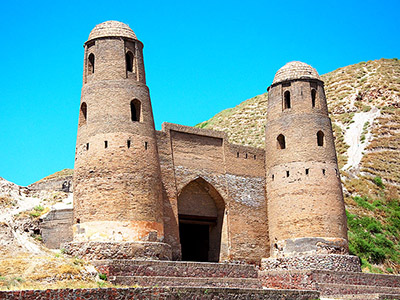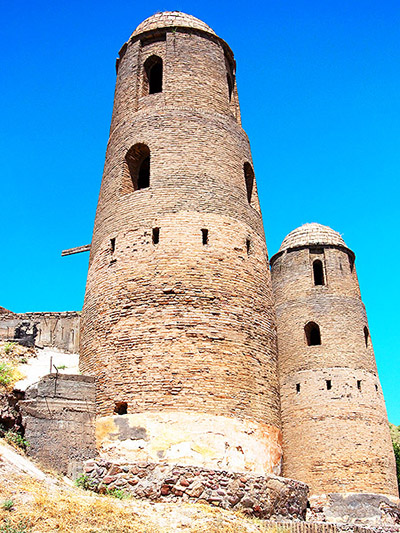The Madrasa Kuhna - Architectural Monument at the Walls of Ancient Gissar

The historical landmark of the Madrasa Kuhna is a madrasa that was built in 16th century as a part of the architectural complex at the Historical Park of Gissar, 25 kilometers away from Tajikistan's capital city of Dushanbe.
"The Madrasa Kuhna" in the Tajik language means "the old madrasa". Even though the building was erected almost five centuries ago, this is not the main reason why it is referred to as old.
Approximately 150 years after the old madrasa was finished, another one was built nearby. People began to call the newly appeared madrasa as simply "the new", and the former building took on the title "the old". Some local historians believe that a third madrasa once existed in front of the older two. It is usually described as a wooden structure and may have been built shortly after the Madrasa Kuhna.
A medieval university

A madrasa is an Islamic seminary or school. They existed and operated on the premises of mosques, meeting houses, mausoleums, and administrative buildings in the Bukhara Emirate and remote mountainous regions. The status of each madrasa varied—the ones in smaller towns in mountainous villages were relatively small and served as middle schools. Other madrasas such as the Madrasa Kuhna were based in larger towns, functioned as higher educational institutions, and could fit hundreds of students in their “darskhonas” (auditoriums).
Students in small madrasas studied Quran and Arabic calligraphy. More substantial institutions offered, in addition to Islamic subjects, courses on astronomy, logic, and arithmetic. However, the teachers taught all disciplines through the lens of religious thought.
Students at madrasas were segregated by gender, and therefore the Madrasa Kuhna only accepted boys as students. They were enrolled at the age of 14 after they graduatd from an elementary school (“maktab").
Although the carved wooden gates of the Madrasa Kuhna were open to every social class, its students were mostly from wealthy families. Lower income parents could not afford to send their sons to the Madrasa Kuhna—every pair of hands in those families were used to work in the household.
However, education at the madras was free of charge. The state did not financially support religious institutions, so instead they received donations from students, local residents, and pilgrims.
The Sheikh's Mausoleum
Of course, the Madrasa Kuhna was not the main destination for these pilgrims, who traveled to visit the nearby mausoleum of Makhdumi Azam. Madrasas were often situated in connection to holy burial sites. But there is no clear evidence that the Madrasa Kuhna and the Makhdumi Azam mausoleum were part of a single institution.
Makhdumi Azam’s mausoleum is the oldest monument in Gissar. It was founded in 16th century and constructed in an architectural style similar to mausoleums in Ura-Tyube (today called Istaravshan).
The name itself, "Makhdumi Azam", is a title, which means "The greatest lord”, and there are several shrines in Central Asia that bear this name. Historians believe that mausoleum in Gissar was built for Hoji Muhammad Kheivaki, a religious practitioner and statesman.
According to written sources, the mausoleum above the sheikh's grave was constructed by Khusain of Khorasm in 1547. It is comprised of three dome-like chambers: the “ziyoratkhona” (place for prayer), “gurknona” (shrine), and an additional mausoleum, in which scientists to this day do not know who is buried.
The architectural patterns indicate that the chambers were built in different periods. The ziyoratkhona and the gurknona were built first, and the third chamber was finished at a later date.
The title "Sheikh" (leader of Muslims) indicates that Kheivaki was also a religious mentor for the people. This title was only granted to someone who had a proven ancestry to the Prophet Muhammad, and served as a key factor for a leader’s legitimacy. During those times when leaders gained and lost power rapidly, those with Muhammad’s blood running through their veins were perceived as holy.
The very definition of "holy" was formulated by the Sufis (the mystic branch of Islam), whose teaching spread widely during those times. According to them, the connection between the people and God could only be ensured by holy ones (saints)—the ascetics and dervishes who rejected worldly pleasures.
After the death of a saint, his grave became a place for pilgrimage. The saint's disciples would build the mausoleums and other rooms such as a warden's room, lodges for pilgrims, and a mosque.
The last classes in the madrasa
At the same time as the completion of the Makhdumi Azam mausoleum, Shaybani-khan, the founder of the 101-year Shaybani dynasty, conquered Gissar. Khisrov-shah, the former ruler of Gissar, fled, and the city became the part of the Bukhara Khanate.
Shaybani-khan did not personally rule Gissar, leaving it to other Shaybanid governors Khamza-sultan and Mahdi-sultan, but the Bukhara Khanate had a unified cultural policy. The Khan was not only a fierce conqueror, but also an educated person who authored poetry and theological works, and he desired to be remembered as such. After about ten years of his rule, Shaybani-khan commanded followers to build madrasas, mosques, and mausoleums. It is possible that the Madrasa Kuhna came into existence as a result of this order.
For over 400 years, until 1921, students continued to take classes in the Madrasa Kuhna. Year after year, summer after summer, young and thoughtful minds discussed various religious issues in the tree-lined yard. During long winter nights, while trying to keep warm in their rooms or at the sandali heating table, they studied old manuscripts from the madrasa’s library.
While walking these old corridors, one can clearly picture such scenes. Visitors need to only use their imagination when standing under the impressive arches the madrasa's entrance, strolling around the courtyard, or peeking into student rooms through the door bars. The ancient atmosphere of the place will do the rest.
In 2013, the Embassy of the United States through the Ambassador's Fund for Cultural Preservation launched a $72,000 project to support and preserve the museum of the unique architectural complex of the Madrasa Kuhna.



